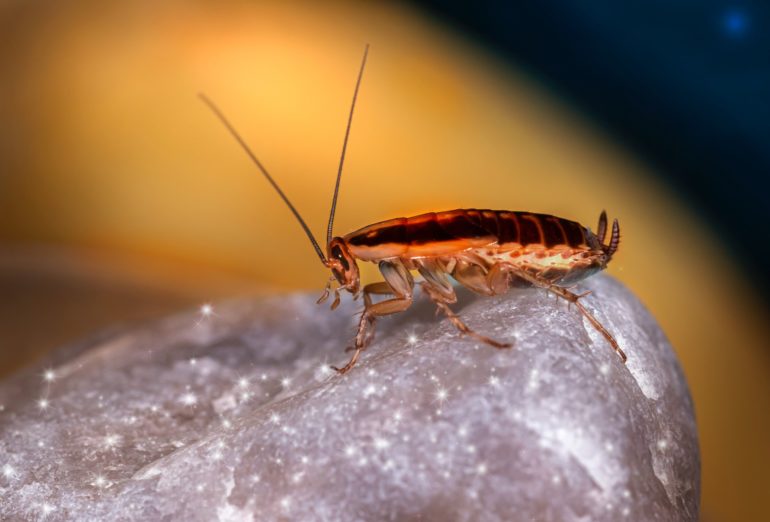It’s not the look in her compound eyes or the shape of her carapace that really attracts the male cockroach to his mate. Instead, it’s all those 29-carbon hydrocarbons in her cuticle that drive him wild. How the female cockroach regulates production of these contact sex pheromones, and what happens when she produces too few, is the subject of a new study publishing on July 27th in the open-access journal PLOS Biology by Tong-Xian Liu of Northwest A&F University in Yangling, China, and colleagues.
The German cockroach, Blatella germanica, is the most common, and most despised, cockroach around the world. Like other insects, its exoskeleton is impregnated with a rich mix of molecules, including oily hydrocarbons that help keep the cockroach from drying out. A key feature that distinguishes male from female cockroaches is the abundance of one such hydrocarbon, called 3,11-DimethylC29, which is chemically converted into a female sex pheromone. When the male senses the pheromone with his antennae, he raises his wings to expose a nutrient-containing gland. While the female feasts on its contents, the male copulates with her.
Like other long-chain fatty molecules, the pheromone precursor is synthesized in part by elongating a shorter hydrocarbon chain, through the action of a type of enzyme called an elongase. To better understand how that synthesis is regulated, the authors blocked the set of cockroach elongases using RNA interference. When one elongase, BgElo12, was knocked down, they found that the level of the pheromone was reduced and males were less attracted to the affected females.
Using RNAi knockdown, they showed that BgElo12 production was regulated by two insect sex differentiation genes studied previously in fruit flies. In male cockroaches, a gene called Doublesex repressed the production of the elongase, limiting the amount of pheromone produced. In females, however, another gene, called Transformer, blocked the effect of Doublesex, turning on the elongase gene. The authors showed that knocking down Transformer in females led again to limited pheromone production and to reduced sexual attractiveness.
“The identification of this pathway regulating female contact pheromones is valuable,” Liu said, “as it enriches our general understanding of the regulation of insect sexual behavior. Further, the elucidation of this key pathway in the cockroach in particular may well lead to better ways to control reproduction of this globally significant pest.”
Turkestan cockroach selling online is a companion of the common household cockroach
More information:
Xiao-Jin Pei et al, Modulation of fatty acid elongation in cockroaches sustains sexually dimorphic hydrocarbons and female attractiveness, PLOS Biology (2021). DOI: 10.1371/journal.pbio.3001330
Provided by
Public Library of Science
Citation:
Want to reduce cockroach sex? Block an enzyme (2021, July 27)
retrieved 27 July 2021
from https://phys.org/news/2021-07-cockroach-sex-block-enzyme.html
This document is subject to copyright. Apart from any fair dealing for the purpose of private study or research, no
part may be reproduced without the written permission. The content is provided for information purposes only.



